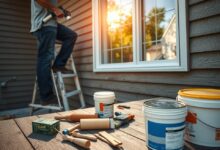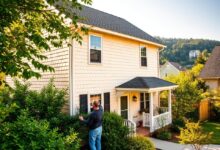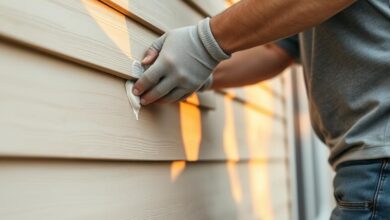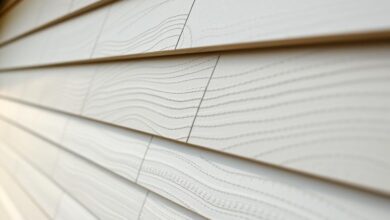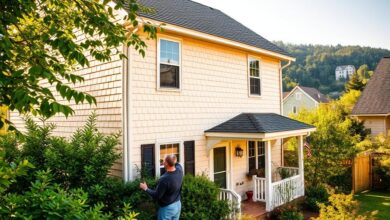Wood Insulated Siding: Enhance Your Home’s Curb Appeal
Boosting your home’s curb appeal and saving on energy costs is a great deal for homeowners. Installing wood insulated siding is a smart choice. It combines the natural look of wood with insulation’s energy-saving perks.
Choosing this siding can make your home look better and feel more welcoming. In this article, we’ll dive into the advantages of wood insulated siding. We’ll also show how it can change your home’s outside look.
Key Takeaways
- Enhance your home’s curb appeal with a natural, beautiful exterior finish.
- Reduce energy costs with the energy-efficient benefits of insulation.
- Increase your home’s value with a durable and long-lasting siding solution.
- Improve your home’s overall appearance and create a welcoming first impression.
- Explore the benefits of wood insulated siding for your home’s exterior transformation.
What Is Wood Insulated Siding?
Wood insulated siding combines traditional wood siding with modern insulation. It creates a durable, energy-efficient, and attractive exterior finish. This product is designed to meet homeowners’ needs for exterior cladding.
Definition and Core Components
Wood insulated siding is made by mixing wood fibers with insulation materials. It offers both beauty and practical benefits. The main parts are a wood base, insulation (like foam), and a protective finish.
How It Differs from Traditional Siding
Wood insulated siding is different from traditional siding. It provides more than just protection and looks. It also reduces heat transfer and lasts longer. This is thanks to the insulation inside the siding.
The Science Behind Insulated Wood Products
The science behind insulated wood products focuses on materials with high R-values. R-values show how well materials resist heat flow. By adding insulation to siding, homes become more energy-efficient and save on costs.
| Key Features | Benefits |
|---|---|
| Insulation Material | Reduced heat transfer, energy efficiency |
| Durable Construction | Long-lasting, weather resistance |
| Aesthetic Appeal | Enhanced curb appeal, design versatility |
The Aesthetic Impact of Wood Insulated Siding
Wood insulated siding is gaining popularity for its style, durability, and energy efficiency. It boosts a home’s curb appeal and fits many architectural styles.
Curb Appeal Enhancement
Wood insulated siding makes a home look natural and warm. It’s hard to find this with other materials. Homeowners can pick from many textures and finishes to match their style.
Available Styles, Textures, and Finishes
Wood insulated siding is very versatile. You can choose from lap siding, board and batten, and shake siding. Each style has its own look. You can also finish it in many ways, like stains or paint, to make it your own.
Design Versatility for Different Architectural Styles
Wood insulated siding works well with both traditional and modern homes. It’s adaptable to many architectural styles.
Traditional Home Applications
For traditional homes, wood insulated siding keeps the classic look while saving energy. It looks great with traditional features like columns and shutters.
Modern Home Applications
In modern homes, wood insulated siding stands out against materials like metal and glass. Its natural tones enhance the clean lines and simplicity of modern architecture.
Benefits of Wood Insulated Siding
Homeowners are choosing wood insulated siding more often. It offers energy efficiency and durability. This siding is a great choice for those wanting to upgrade their homes.
Energy Efficiency Advantages
Wood insulated siding boosts energy efficiency. It adds insulation, cutting down on heat loss in winter and heat gain in summer.
R-Value Comparisons
The R-value shows how well a material stops heat flow. Wood insulated siding has a higher R-value than many materials. For example, some products have an R-value of up to 3.5, much higher than vinyl siding.
Seasonal Performance
Wood insulated siding works well in all seasons. It keeps homes warm in winter and cool in summer. This makes it a great choice for homes in many climates.
Durability and Weather Resistance
Wood insulated siding is durable and weather-resistant. It can handle rain, snow, and extreme temperatures. This means it lasts longer, saving you money on replacements.
Noise Reduction Properties
Wood insulated siding also reduces noise. The insulation layer blocks outside sounds, making your home quieter and more comfortable.
Environmental Benefits
Wood insulated siding has environmental benefits. It’s made from natural, renewable materials and can be recycled. Choosing it helps reduce your environmental impact while improving your home’s look.
In summary, wood insulated siding offers many benefits. It’s energy efficient, durable, reduces noise, and is good for the environment. It’s a smart choice for homeowners looking to improve their homes.
Types of Wood Insulated Siding Products
The market has many wood insulated siding products like cedar, pine, spruce, and engineered wood. These choices meet different homeowner needs. They vary in durability, maintenance, and looks.
Cedar Insulated Options
Cedar insulated siding is loved for its natural defense against rot, decay, and insects. It has a unique, rustic look that many homeowners like.
Features and Performance
Cedar insulated siding is very durable and can last for decades with the right care. It also doesn’t warp or shrink much, keeping its shape over time.
Pros and Cons
Cedar insulated siding is beautiful, durable, and pest-resistant. But, it costs more than other options. It also needs regular upkeep to keep looking good.
Pine and Spruce Varieties
Pine and spruce insulated siding are cheaper than cedar. These softwoods can be treated to make them last longer and fight off the weather.
Features and Performance
Pine and spruce insulated siding is affordable and can be made to keep warm well. They need more care than cedar but are a budget-friendly choice.
Pros and Cons
Pine and spruce insulated siding is cheaper and works okay. But, they’re not as long-lasting as cedar. They might need more upkeep.
Engineered Wood Insulated Products
Engineered wood insulated siding mixes wood fibers with other materials. This makes it more stable and durable. It looks natural but lasts longer.
Features and Performance
Engineered wood insulated siding is made to not warp or shrink much. It looks the same over time. It’s also better for the environment than solid wood.
Pros and Cons
Engineered wood insulated siding is stable, needs less care, and is eco-friendly. But, it might not look as natural as solid wood. Its price can change based on who makes it.
| Type of Siding | Durability | Maintenance | Cost |
|---|---|---|---|
| Cedar Insulated Siding | High | Periodic | Higher |
| Pine/Spruce Insulated Siding | Medium | Frequent | Lower |
| Engineered Wood Insulated Siding | High | Low | Variable |
Installation and Maintenance Considerations
To get the most out of wood insulated siding, homeowners must consider both the installation process and long-term maintenance needs. The performance and longevity of this siding option are directly influenced by these factors.
Professional vs. DIY Installation Analysis
Deciding between professional installation and DIY is a big decision. DIY can save money, but it needs a lot of skill and time. Professional installers have the experience and speed to do the job right, reducing the chance of problems later.
Key considerations for DIY installation include:
- Assessing your skill level and available time
- Understanding local building codes and regulations
- Ensuring proper measurements and material handling
Installation Process Overview
The installation of wood insulated siding involves several key steps:
- Preparing the exterior surface by cleaning and checking for damage
- Installing a weather-resistant barrier
- Attaching the siding panels, starting from the bottom and working upwards
- Ensuring proper alignment and spacing between panels
Maintenance Requirements and Best Practices
Regular maintenance is key to keeping wood insulated siding in good shape. This includes:
- Inspecting the siding annually for damage or wear
- Cleaning the siding with a mild detergent and water
- Reapplying finish or sealant as needed
Longevity Expectations and Warranty Information
The lifespan of wood insulated siding depends on the material, how it’s installed, and how well it’s maintained. It can last 20 to 40 years or more. Knowing what the manufacturer’s warranty covers is important for protecting your investment.
| Maintenance Activity | Frequency | Benefits |
|---|---|---|
| Inspecting for damage | Annually | Early detection of issues |
| Cleaning | As needed | Maintains appearance and prevents dirt buildup |
| Reapplying finish | Every 5-10 years | Protects the siding from weathering |
Conclusion: Making the Right Choice for Your Home
Choosing the right siding for your home can be tough. But wood insulated siding is a great option. It makes your home look better and saves energy.
Wood insulated siding combines natural beauty with modern insulation. It makes your home look great and feel comfortable. Plus, it’s good for the environment.
Wood insulated siding has many benefits. It saves energy, lasts a long time, and is eco-friendly. Choosing it makes your home more valuable.
Think about using wood insulated siding for your next home project. It looks good and offers many benefits. It’s a smart choice for your home.



